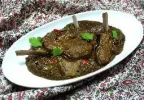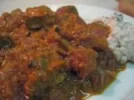- Joined
- Mar 16, 2002
- Messages
- 6,660
- Reaction score
- 578
There are many on this forum who like some form of Indian food. I decided to create thread for posting some very interesting or classic dishes which can be tried by anyone interested. Some simple recipes can be also tried at home if you do not feel like going to a resturant. I will be posting recipes here which may not be my own but from various publications and something which I feel is a good example of the particular dish. I hope this thread would be found useful.
As we go along anyone can post here and ask any questions, give suggestions or ask for a particular recipe. I will do my best to oblige.
I posted a recipe on another thread which I think I will start off with today. Its the Chicken Tikka, and a very simple dish to experiment with.
Chicken Tikka
Ingredients

As we go along anyone can post here and ask any questions, give suggestions or ask for a particular recipe. I will do my best to oblige.
I posted a recipe on another thread which I think I will start off with today. Its the Chicken Tikka, and a very simple dish to experiment with.
Chicken Tikka
Ingredients
- 2 pounds chicken legs, thighs or breasts
- 1 teaspoon salt
- 1 teaspoon red chili powder
- 1 teaspoon coriander seeds, roasted, ground
- 2 teaspoons garlic - minced
- 2 teaspoons ginger, fresh - grated
- 4 tablespoons plain yogurt (full fat)
- 2 tablespoons lemon juice or white wine vinegar
- 1/2 teaspoon black pepper - ground
- vegetable oil
- NOTE : You can add some red food coloring to the marinade paste for the traditional red color of this chicken dish.
- Remove the skin and make 2-3 deep cuts in each chicken piece.
- Roast the corriander seeds in a hot cast iron skillet. After cooling, grind to powder.
- Mix all dry ingredients with the lemon juice or vinegar and make a paste.
- Put this paste onto chicken pieces and leave them for at least 4-5 hours to marinate. Better if left in refrigerator over night.
Grill method - Rub each piece of chicken with a few drops of vegetable oil.
- Grill the chicken using indirect heat over hot coals.
Oven method - Put the chicken pieces (with the paste still on it) onto a broiler tray and cover them with aluminum foil.
- Put the tray into a medium oven (350 F) for 30 minutes.
- Then remove tray and pour off any liquid. Baste chicken with 2 tablespoons of oil and return to the oven for another 15 minutes until outside of chicken is crispy.



 great idea
great idea 




